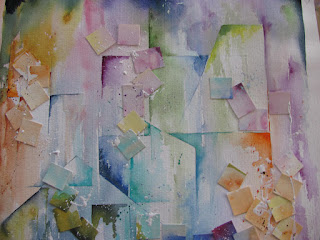Today the subject was `Abstracts' . Yvonne brought a number of boxes and set them up in two places.
The idea was that you produce an abstract painting, or drawing, based on this arrangement. This was kept secret until the actual morning so we were all in the dark, apart from Yvonne! I must admit I was not looking forward to it. The previous evening I pulled out my copy of the Kees van Aalst book `Realistic Abstracts' but found little inspiration. Not to say it isn't a good book because it is, but considerable study and practice is required to understand what abstraction is all about. I've looked at it several times, found it very interesting, especially in regard to some of the featured artists, but not really delved into it in any great detail. This book though mixes abstraction with realism so isn't entirely suitable for pure abstraction. Search Press produce two other books, by the same artist Rolina van Vliet, called `The Art of Abstract Painting' and `Painting Abstracts', which for those seeking to understand the subject are probably better. There are books by other publishers but I have an increasing regard for Search Press, who are producing very good, economically priced, practical art books, amongst a range of other subjects.
In the event faced with these boxes my creative abilities shrivelled, such as they are, and I made a very poor fist of it, one of the problems being I don't like lots of straight lines. However my fellow members, thirteen on this occasion, made much better attempts.
Yvonne Harry
Yvonne was not overly happy with this and said she would be making changes/additions. No doubt the finished work will appear on her blog in the next few days. Specifically she felt it a little weak on colour and needed some curved lines. Some thought she was being over critical.
Pauline Vowles
Pat Walker (Acrylic)
Helen Newman
Sue Macy
Jo McKenna
Robert Heal
My dreadful effort is at bottom right
I think some of the above are pretty good given the subject and the fact there was no real time to plan prior to the meeting. It is certainly not my bag at all but some of the others take a different view. I took my copy of the Kees book to the meeting and Pat Walker after perusng it was planning to buy a copy from Amazon (£9.09p). The subject next week is `Autumn'.




























































